‘These Trees’ Art Installation Weaves Cross-Campus Connections
Friday, September 26, 2014
Over two weeks, more than 160 students from various majors participated in the creation of “These Trees,” an art piece utilizing a variety of tree species harvested from Penn College’s Schneebeli Earth Science Center and installed on the west lawn of the Bush Campus Center at the college’s main campus in Williamsport.
Working alongside internationally known environmental artists Kathy Bruce and Alastair R. Noble, the students assisted in creating Bruce and Noble’s vision of a spiraling text quoting William Shakespeare’s “As You Like It.”
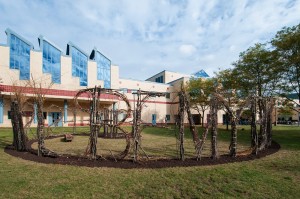 Interwoven tree branches form the sculptural installation that reads: “These trees shall be my books,” and at the center of the spiral, a log bench is engraved with the next line of the play, “And in their barks my thoughts.” The spiral reflects the natural growth of plants and the mathematical rhythm that is expounded in the Fibonacci series and the basis of the golden ratio.
Interwoven tree branches form the sculptural installation that reads: “These trees shall be my books,” and at the center of the spiral, a log bench is engraved with the next line of the play, “And in their barks my thoughts.” The spiral reflects the natural growth of plants and the mathematical rhythm that is expounded in the Fibonacci series and the basis of the golden ratio.“We’re responding to the architecture, the trees, this site, this town,” Noble said. “With logging having been the main industry of Williamsport during the late 19th century, we wanted the work to be related to that, to embrace that. And why did we address this particular phrase? We felt the trees and the books had educational references within the context of this institution.”
Penny Griffin Lutz, manager of The Gallery at Penn College, which helped to coordinate the artist-in-residence project, said the diversity of the college’s programs of study are reflected in the effort.
“Students from all six academic schools and faculty from four of the schools participated in the art installation,” Lutz said. “While working hands-on alongside the students, the artists were able to educate them about the importance of environmental art and discuss the impact art has on life, no matter what your major or job.”
Students whose classes focused on architectural technology, forest technology, horticulture, industrial and human factors design, English, environmental science, ceramics and wood sculpture, and digital video were among those who either assisted in the hands-on creation of “These Trees” or conducted research at the site. The students hailed from a wide range of majors. Among the student organizations joining in the project were the Horticulture Club, Forestry Club and Gamers’ Guild. Students who were not part of an organized class or club also dropped by to assist or converse with the professional artists and fellow students.
“It was very interesting to observe the range of reactions, thoughts and ideas that the students discussed as they worked,” said D. Robert Cooley, assistant professor of anthropology/environmental science, who brought two sections of his environmental science class to the site. “I overheard a few discussing the quote and its source – Shakespeare. I heard others comparing how the branches’ and vines’ organic curves were different from the straight lines they typically experience in collision repair. I even heard some talking about how something like this is what college is all about – that it gives students the chance to stop and think about something that takes them outside their daily experience and prompts them to think ‘outside the box.’
“It was an intimate way for students who might not normally interact directly with art or the environment to do both at a very personal level. Several said to me that they were proud to have been a part of the project and looked forward to watching it become a part of the landscape over their next year or two here at Penn College, knowing they helped make it a reality.”
“These Trees” should last at least two years, said Bruce, explaining that the installation is temporary because environmental art strives to create works that are not harmful to the environment.
“Rather than creating more ‘stuff’ in the world, the artwork returns to nature eventually,” Bruce said. “It will change through the seasons; that’s the point of environmental art: The work will respond to nature. Watching the changes becomes part of the process of the project.”
During the two-week installation of “These Trees,” the professional artists and their student mentees enjoyed near-perfect conditions for the duration of the construction.
“It has just been ideal, extraordinary weather,” Bruce said. “We so rarely get weather like this. We’ve been in extreme heat, battling gnats or, on the other end of the spectrum, in cold, wind and rain. The weather here has just been a gift.”
Residents of New York City, Bruce and Noble have created art installations across the globe.
Earlier this year, Bruce was the U.S. representative for an international environmental art project, designed with bamboo, in Taiwan. A site-specific environmental artist, she received her Master of Fine Arts degree from Yale University School of Art and a certificate from The Pennsylvania Academy of Fine Arts. She completed a Fulbright-Hays Senior Scholarship Grant for Lecturing and Research in Puno, Peru, in 2012. Her other awards include a Pollock-Krasner Foundation Fellowship, Pennsylvania Council on the Arts Individual Artist Grant, Fulbright-Hays Junior Scholarship Grant for work in Peru and a Ford Foundation Grant for sculpture. Additionally, the Ithaca, New York, native has completed numerous residencies around the world.
Bruce’s artistic practice typically explores the subject of female mythological figures within the natural environment. Those works often are large, public pieces that reflect or incorporate live plant material specific to the installation site.
Noble, a native of England, is an environmental/installation artist and printmaker. His cross-disciplinary work engages in contemporary cultural issues. He has exhibited extensively both nationally and internationally, including in Peru, Chile, Bulgaria and the United Kingdom. His practice is a response to architecture and the natural environment and investigates particular sites in the context of literature, poetry and philosophical texts.
Additionally, he writes on sculpture and architecture for international sculpture magazines and journals. He has taught and lectures at numerous colleges and universities, where he has organized symposia on the role of public sculpture.
Most recently, Noble finalized an installation of forest-inspired sculptures as part of the Marsh-Billings-Rockefeller National Historic Park Artist-in-Residence program in Woodstock, Vermont. In the 500-acre park there, he produced a series of “waymarkers” – logs shaped with a chain saw and inscribed with short passages extracted from the texts of writers he felt were evocative of the paths and woods he traversed. The incised quotes were embedded with live moss that will continue to grow over the logs as they eventually rot.
The “These Trees” project at Penn College enlightened students and faculty beyond the short construction process. Geoffrey M. Campbell, assistant professor of architectural technology, says the collaboration with the professional artists helped his students learn “about the process and challenges involved in obtaining an art commission, developing the design, and, ultimately, constructing the work."
For aspiring architect Boris Lobo, a sophomore in residential construction technology and management: architectural technology concentration, the project offered unique insights into his craft.
The East Elmhurst, New York, resident and native of Bolivia said the “These Trees” work aligned, in his mind, with the work of one of his favorite architects, Shigeru Ban, an innovative Japanese architect most famous for recycling cardboard to create housing for disaster victims.
“It made me wonder about using branches to make things out of,” Lobo said, “and only using trees – and nothing else – for creating shelters for people who have survived catastrophes.”
“These Trees” and the two other Centennial art installations – one formed from sheet metal and the other featuring mosaic tile, mirror and stone – are outside and available for viewing at any time by the campus community and the general public. The three artworks will also be in the spotlight during Penn College’s Fall Open House on Sunday, Oct. 26, featuring a special public open house from 2 to 4 p.m. during the daylong event.
Throughout 2014, Penn College continues its celebration of 100 years as an educational institution of national reputation.
For more about the college, email the Admissions Office or call toll-free 800-367-9222.
– Photos by Cindy Davis Meixel, writer/photo editor; Dalaney T. Vartenisian, student photographer;
D. Robert Cooley, assistant professor of anthropology and environmental science; and Tom Wilson, writer/editor-PCToday
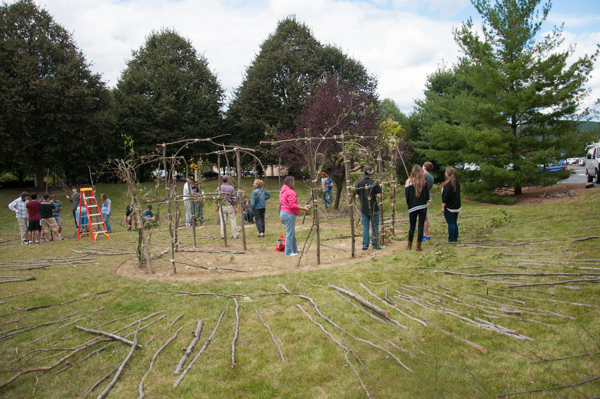
Transplanted and repurposed, "These Trees" rise from their new location.
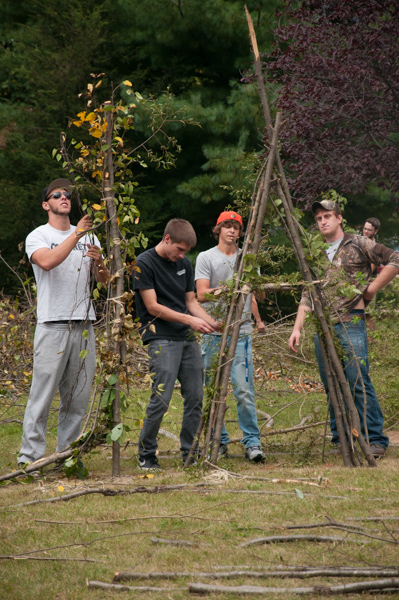
Students from a variety of majors had a role in the project.
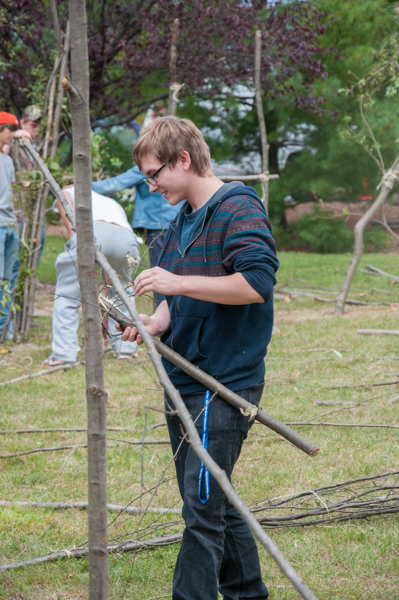
Innovatively adding to a hands-on education
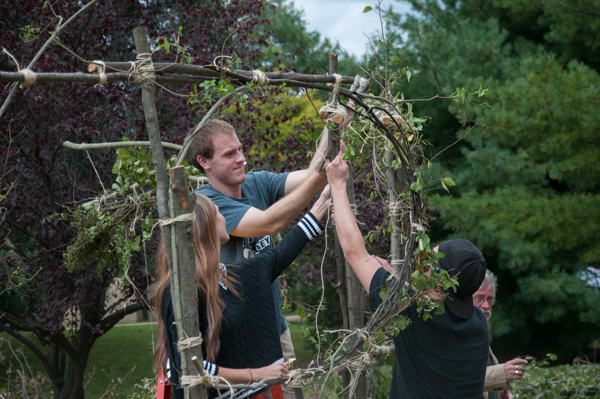
Classmates cooperate in a one-of-a-kind assignment.
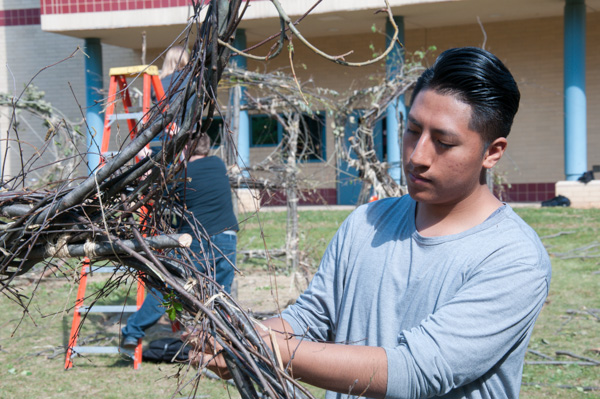
Bolivia-born Boris Lobo finds inspiration through building with natural material.
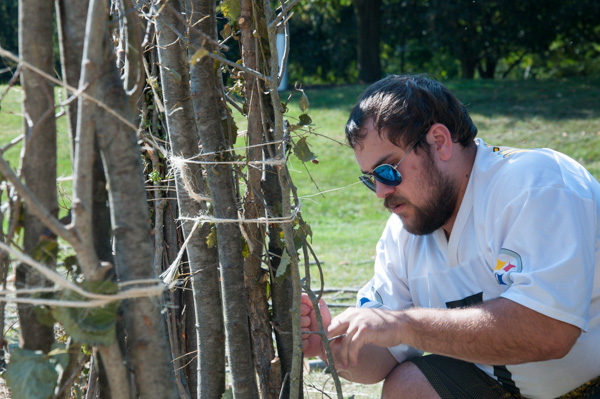
Joshua A. Hunt, a sophomore in building science and sustainable design: architectural technology concentration from Lewisburg, is a study in concentration.
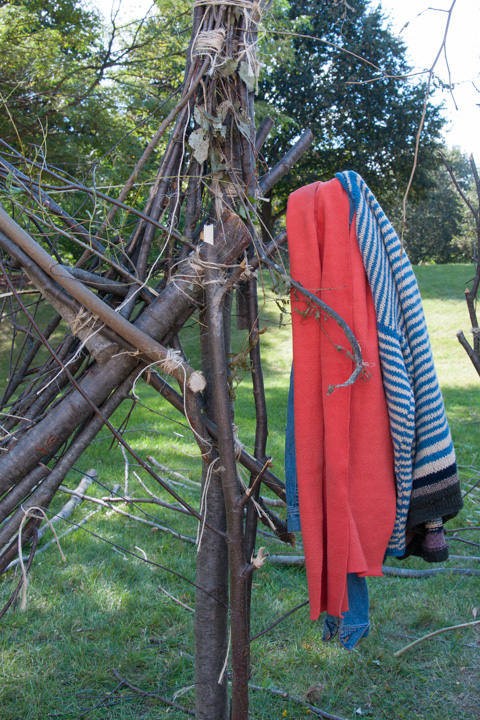
Natural coat hangers were regularly used during construction.
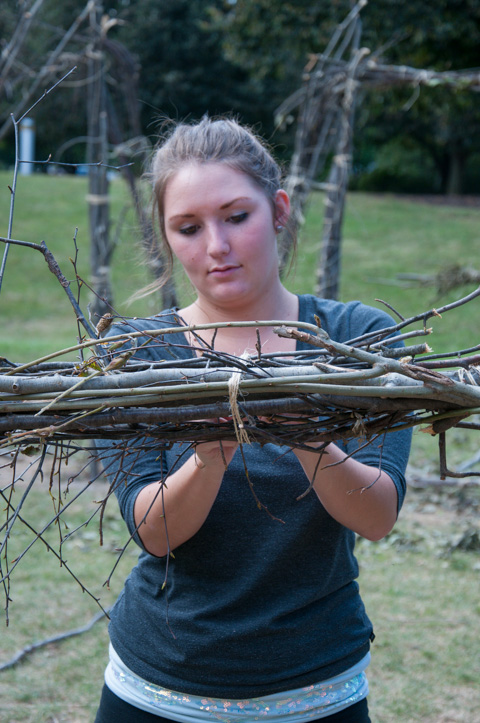
First-year architectural technology major Felicia M. Webber, of New Bloomfield, focuses on the interlocking endeavor.
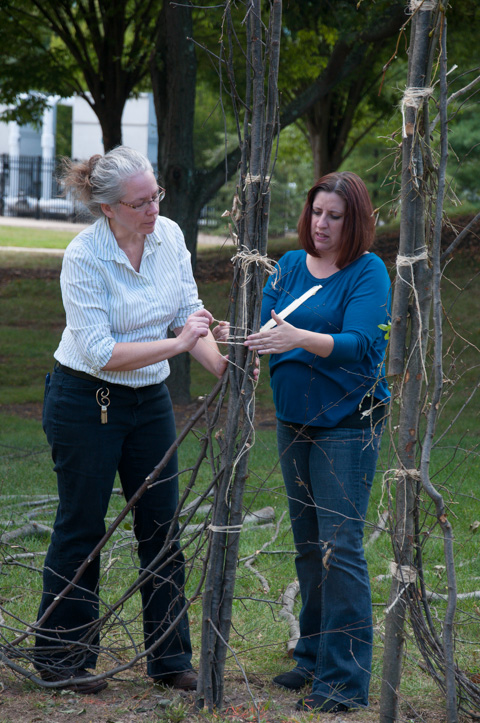
Dorothy J. Gerring (left), associate professor of architectural technology, works with Andrea M. Yoder, a first-year architectural technology student from Northumberland.
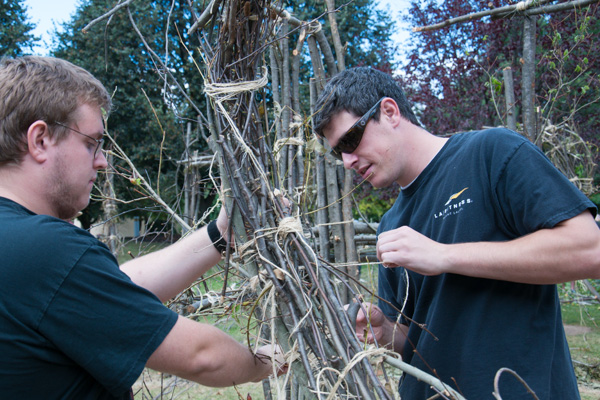
Teaming up for the task are Nathaniel J. DeWalt (left) and Ryan A. Sampson. DeWalt is a freshman in architectural technology from Mainesburg. Sampson is a junior in building science and sustainable design: architectural technology concentration from Downington.
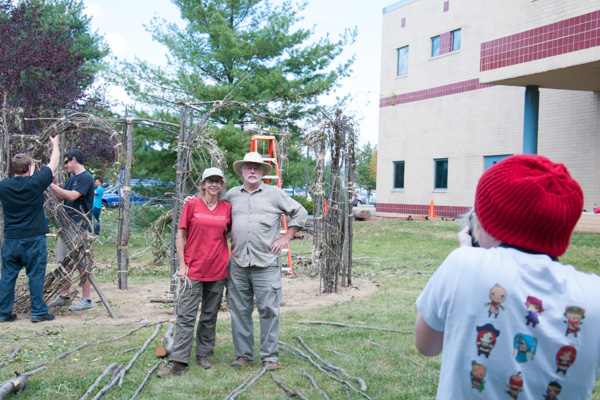
Seamlessly adept at blending interaction with instruction, Bruce and Noble pause to oblige a photograph from a participating student …
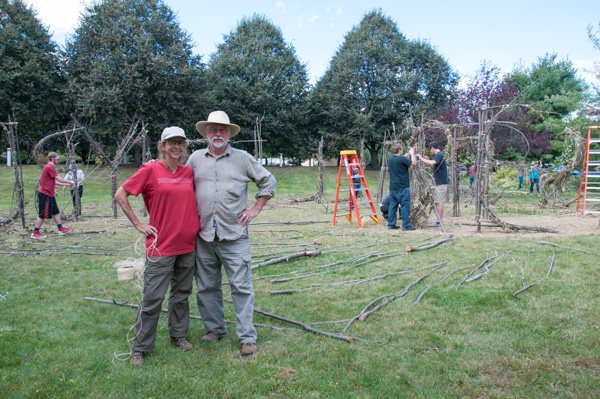
… and yet another, from a college photographer.
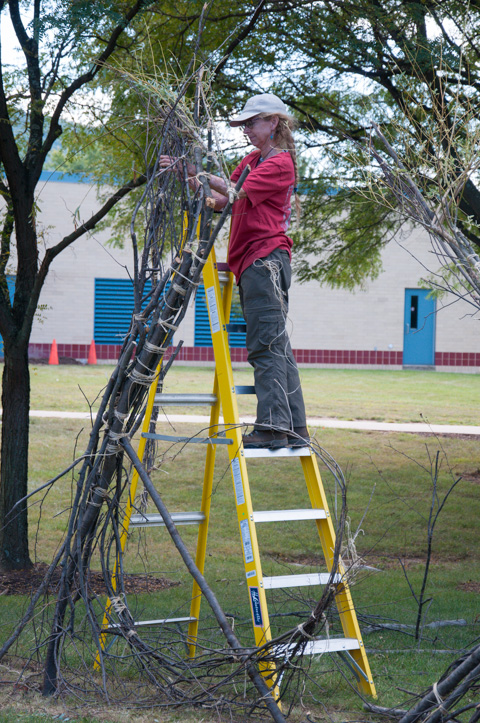
Bruce takes a higher stance.
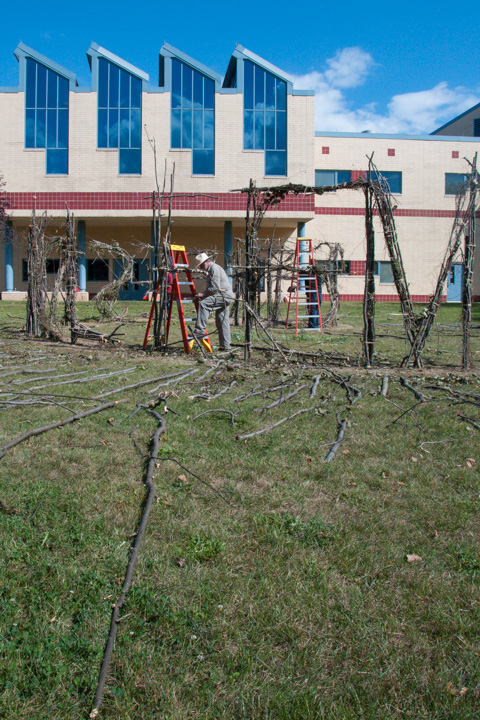
Beautiful blue skies and ideal weather blessed the nearly two-week project.
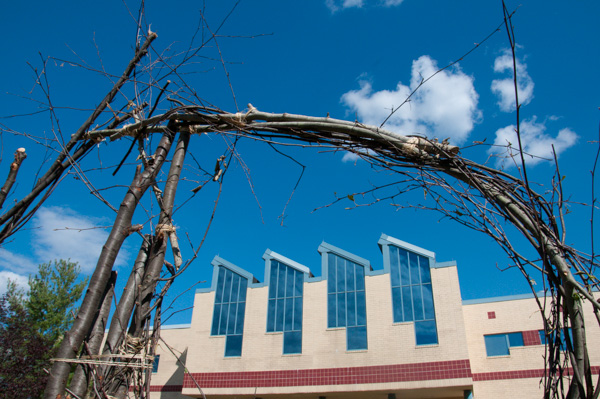
A natural arch of learning and artistry blends with the contemporary campus.
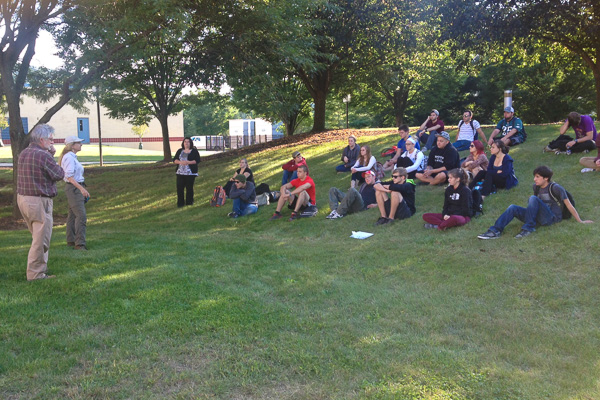
D. Robert Cooley's students attend an artistic overview in a makeshift outdoor classroom.
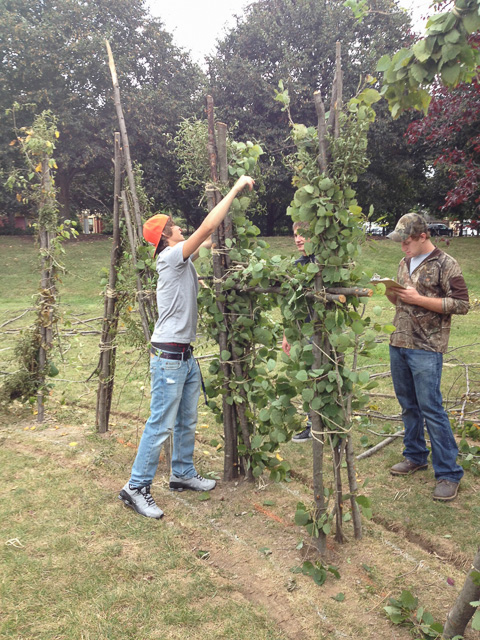
Collaborating on a decidedly "green"-building enterprise.
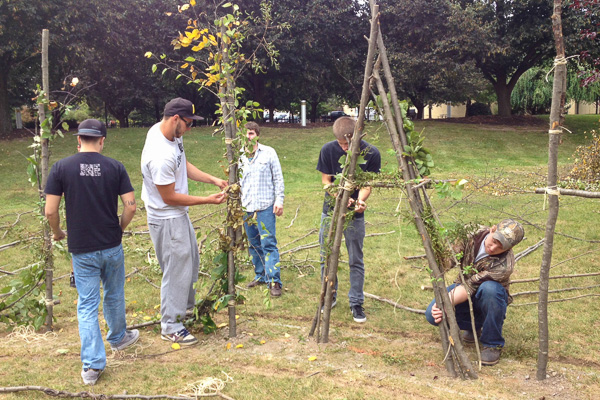
An "A" for effort
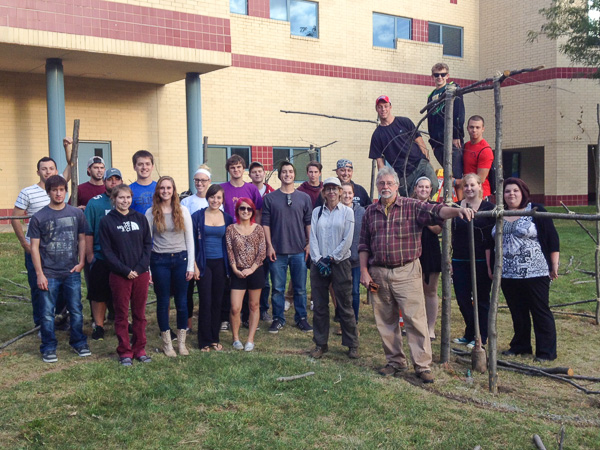
Environmental science students meet environmental artists on the job site
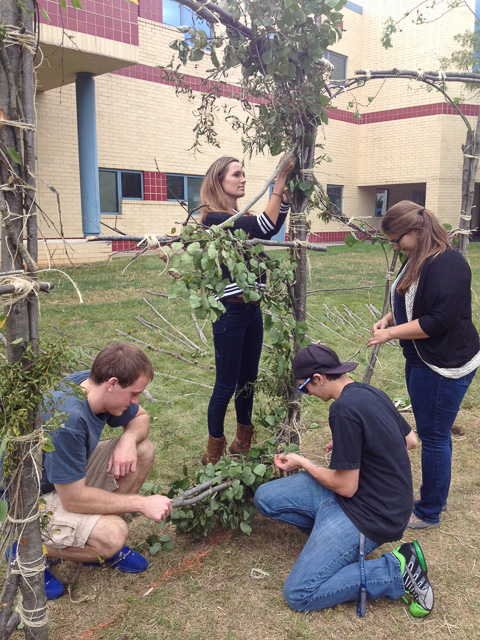
Weaving Shakespeare's words
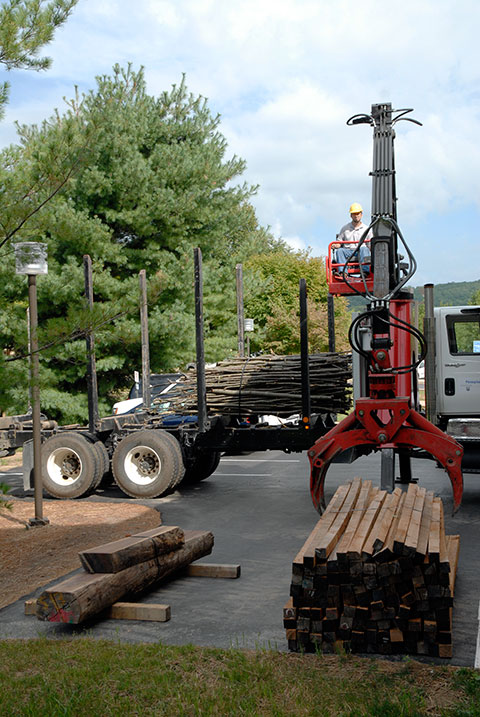
Erich R. Doebler, laboratory assistant for forest technology, delivers the project's raw materials – harvested from the college's Schneebeli Earth Science Center.
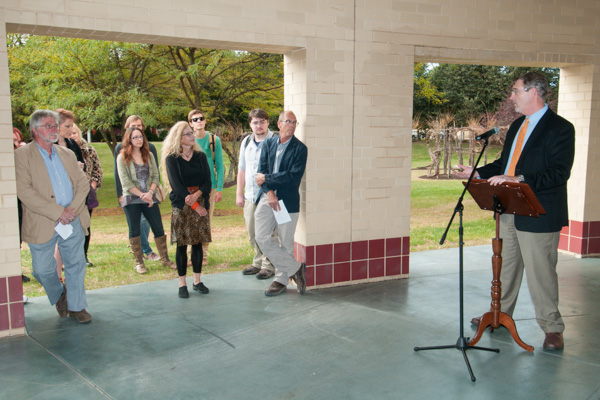
On the Bush Campus Center patio, Paul L. Starkey (right) offers welcoming remarks at Thursday's dedication for two campus art installations: "These Trees" and the Centennial Mosaic. The vice president for academic affairs/provost pointed to the efforts by the three artists (from left), Alastair Noble, Kathy Bruce and Dave Stabley. A third work, "Student Bodies," will be celebrated next month.
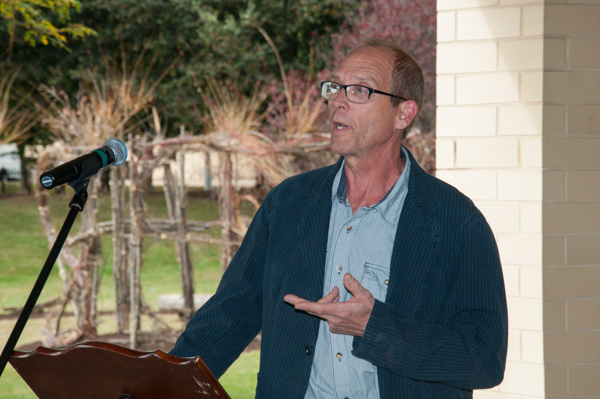
Stabley comments on the Centennial Mosaic work, an effort that took place over four weeks in May and June with the assistance of eight students enrolled in "The Art of the Mosaic" class. The mosaic graces the north wall of the Physician Assistant Center.
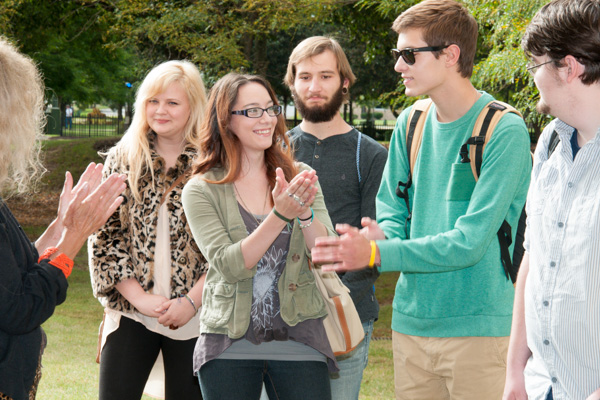
"The Art of the Mosaic" students accept and offer applause for their artistic efforts.
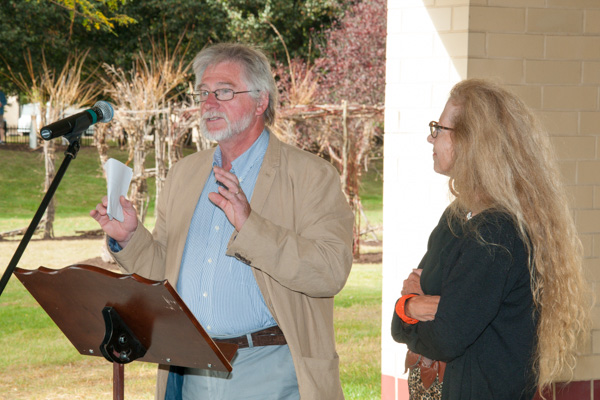
With a portion of their work visible behind them, Noble and Bruce discuss the creative process.
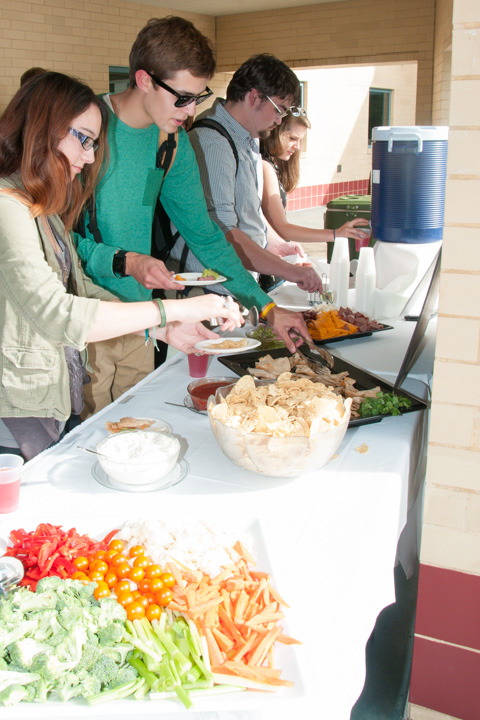
Student artists line up for reception sustenance on the Campus Center patio.
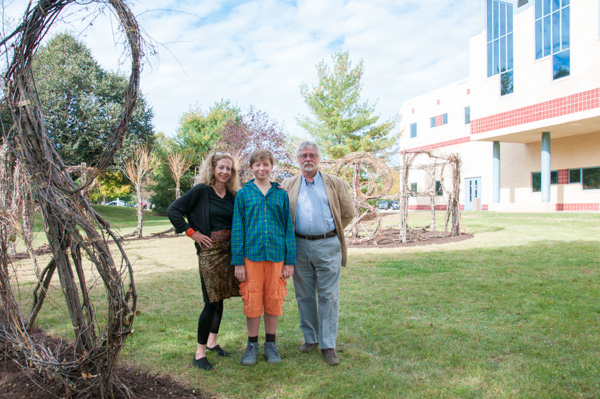
The artists are joined at "These Trees" by their 14-year-old son, Stuart.
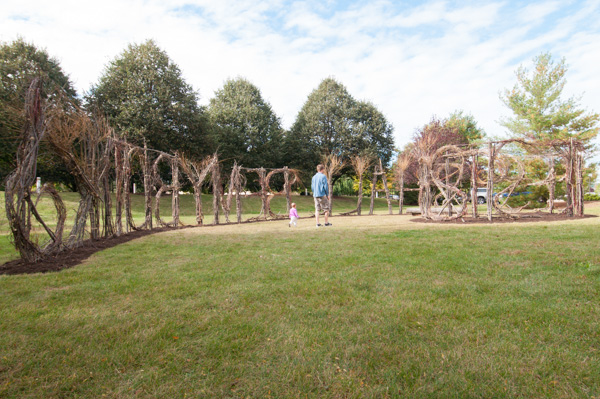
Encouraged by a faculty member, Robert J. McClellan, a sophomore in building construction technology from Yatesville, explores "These Trees" with his daughter, Laylah, after the dedication.
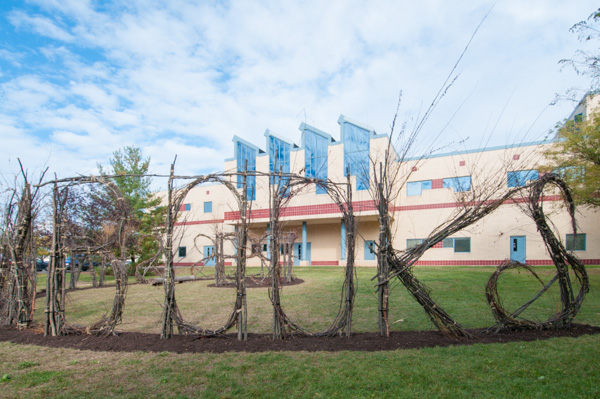
A word that speaks volumes on a college campus
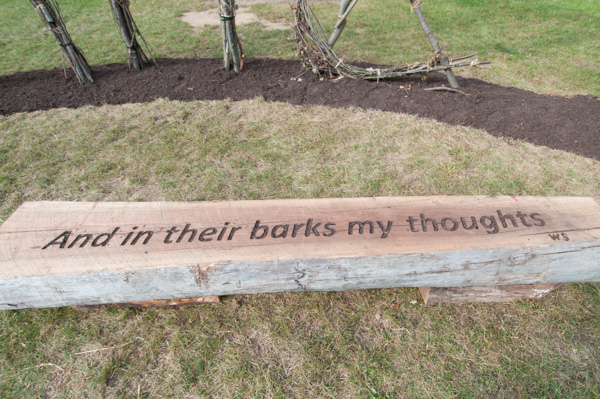
The bard's "barks" are incised into a log bench, along with his initials.
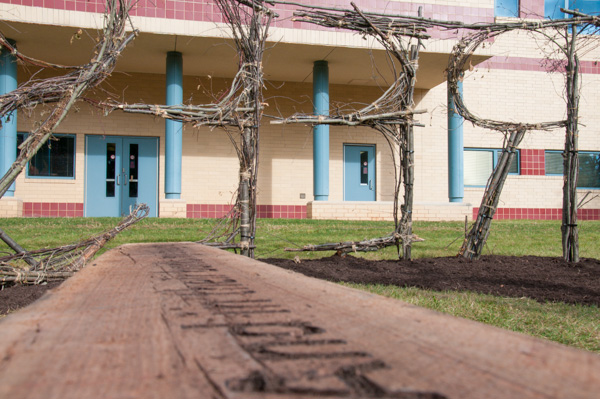
The bench beckons deep thoughts and respite.
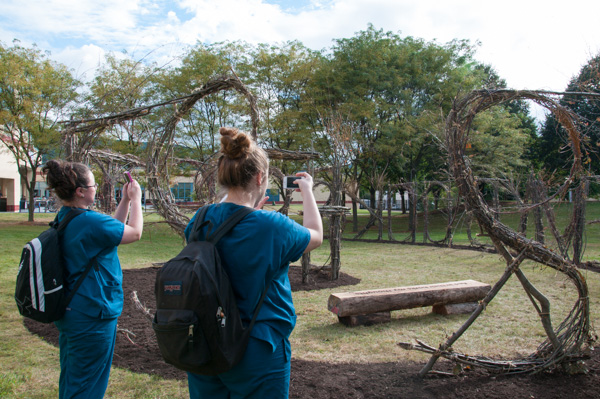
Crystal C. Harrison (left), of York, and Tiana L. Steinbacher, of Montoursville – in their initial semester as dental hygiene: health policy and administration concentration majors – stop on their way to class to snap cell-phone keepsakes of the new campus art.

Part of the artisans' inventory, rustic and rough-hewn
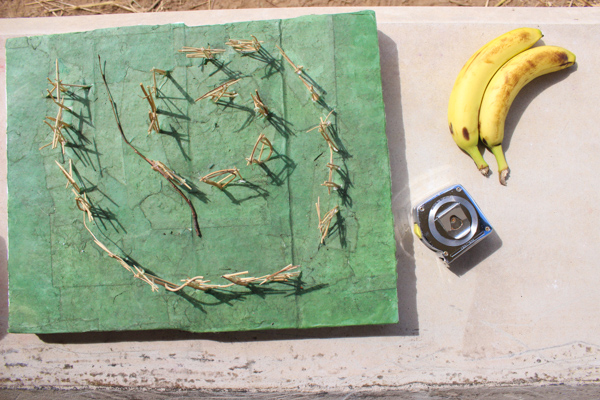
A small-scale mockup, snacks and a tape measure constitute a temporary tableau of a work in progress.
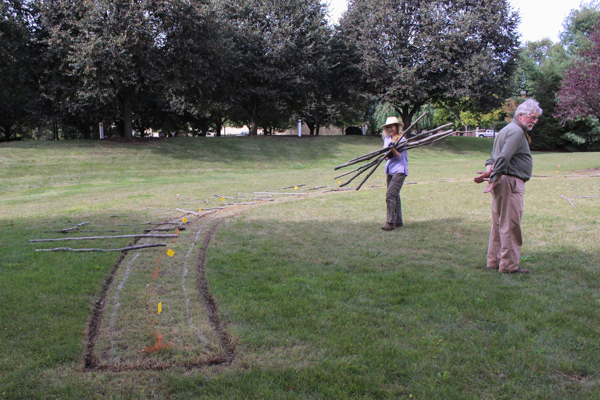
The artists gauge the lay of the land, loosely staking out the task ahead.
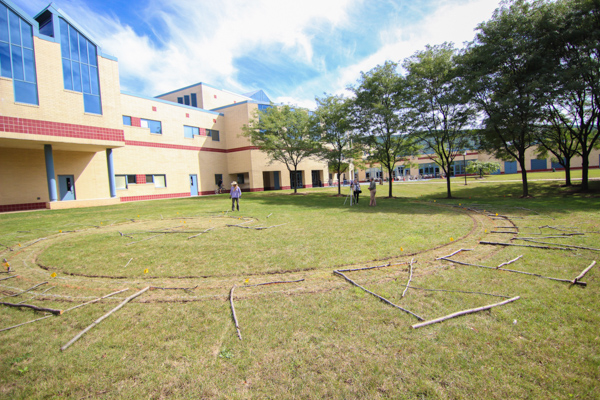
A Fibonacci "floor plan" spirals outward from the artist's vantage.
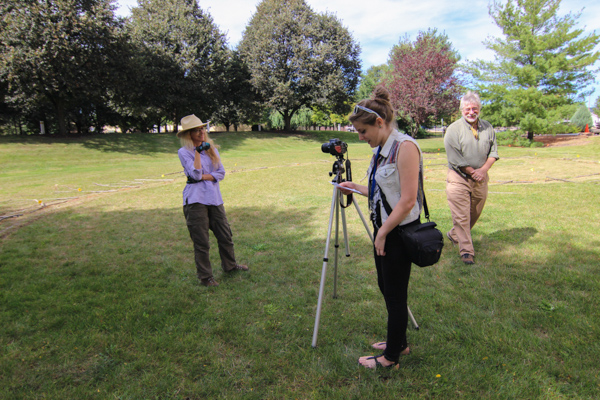
A member of Lisa R. Bock's digital video class adds to the documentary record.
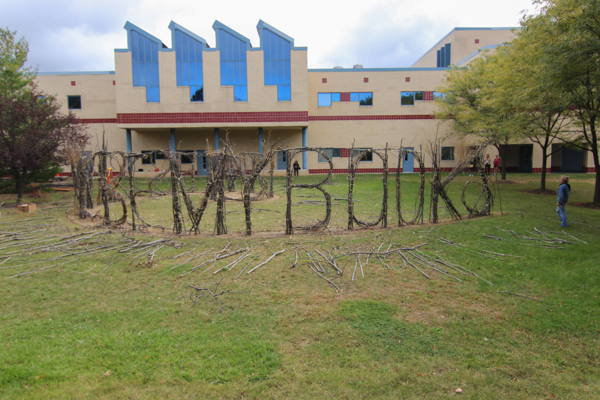
Surveying the progress of a unique landmark
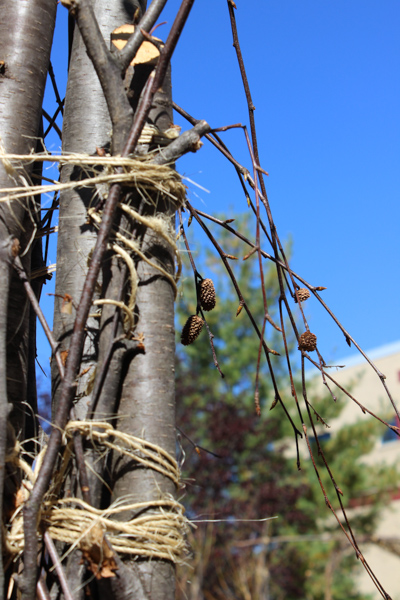
Pine cones affirm the naturalness of the artists' medium (and mirror the fruits of the students' labor).
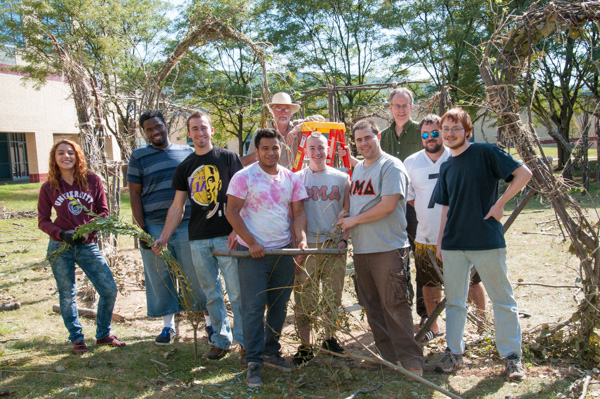
Geoffrey M. Campbell (right rear), gathers with his students and with Noble (left background).
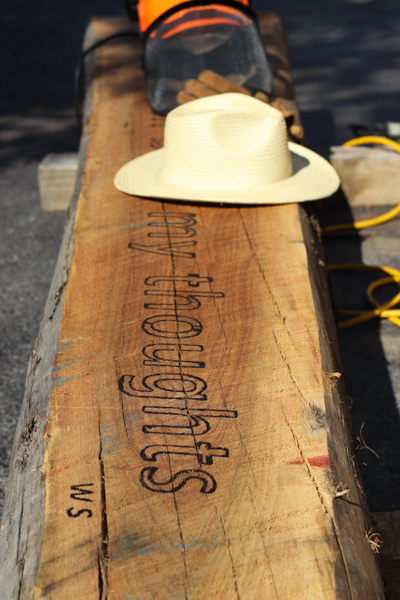
Noble's trademark headgear punctuates timeless poetry.
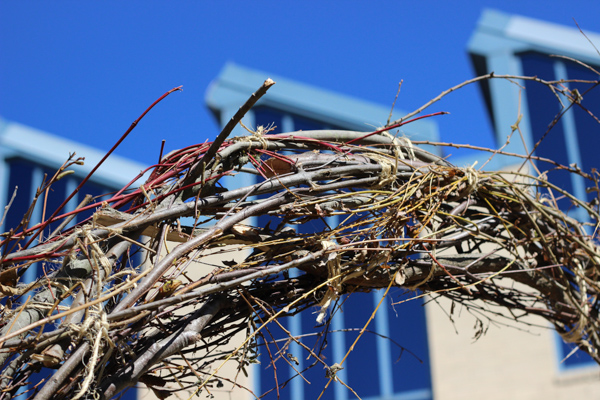
Fashioned from nature, "These Trees" frames the manmade character of the Bush Campus Center to the east.
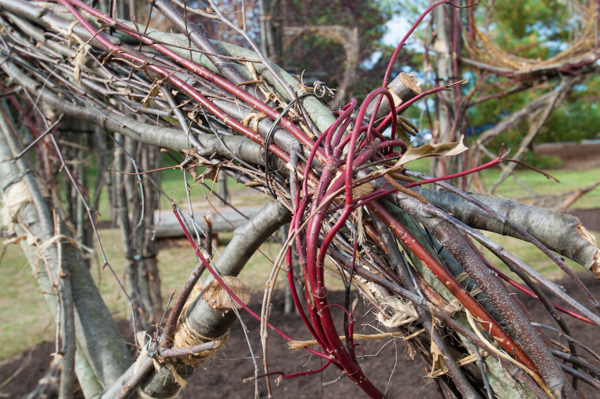
Red vines help bind the branches – and tie together a color scheme duplicated across campus.
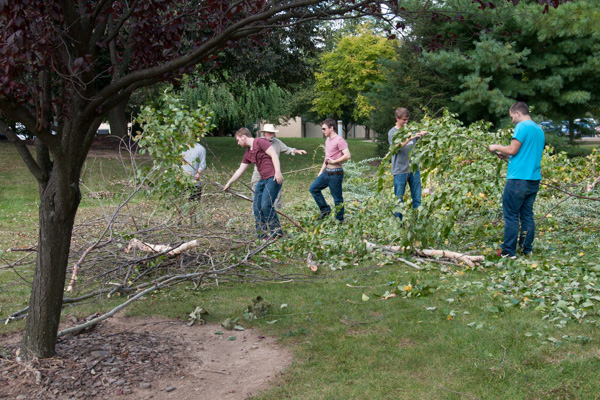
Noble and his young charges move among the piles of potential, choosing just the right pieces to add.
